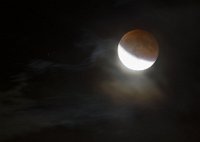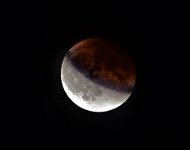 Ring around the Moon 2/27/02 |
 Moon and Jupiter |
 NEW NEWMoon and Jupiter |
 |
 Moon and Venus |
 24-hour-old new Moon |
 Total Lunar eclipse and Saturn |
 Total lunar eclipse 10/27/04 |
 Moon and Venus 5/19/07 |
 Moonrise Milpitas |
 Supermoon eclipse 9/28/15 |
 Supermoon eclipse HDR 9/28/15 |
 Fireworks and the Moon |
 How We Get a Full Moon A non-scientist friend recently called me up with a question: how can we ever have a full Moon? If the Moon is on the opposite side of the Earth from the Sun, wouldn't at least PART of the Earth's shadow fall on the Moon? Well, I KNEW the answer to that question was that the Moon's orbit around the Earth is tilted by about 5.8 degrees. However, the more I thought about it, the less satisfying that answer seemed. I mean, 5.8 degrees really isn't THAT much, is it? So, it finally hit me that I should try and draw a diagram to scale of the Earth-Moon system. When I did, the result startled even me. It REALLY drove home the importance of scientific visualization. What I saw in an instant was that, at the distances involved, 5.8 degrees of tilt is WAY more than enough to take the Moon far, far out of the Earth's shadow for the majority of its orbit. |

